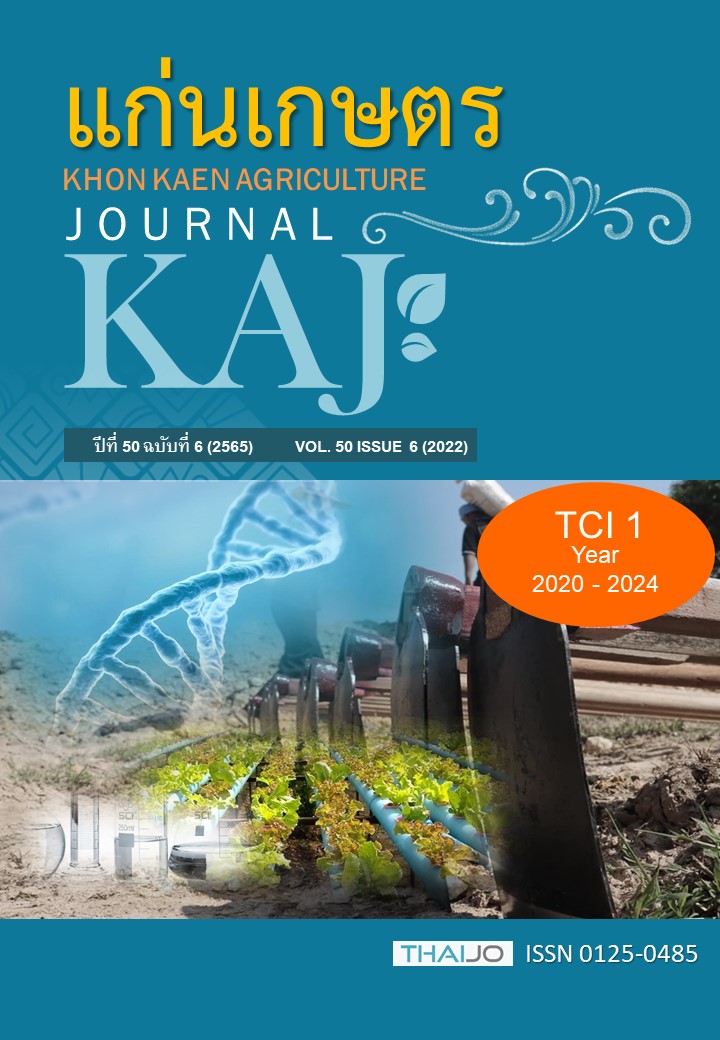อาหารและขนาดของแมลงอาศัยต่อการวางไข่ของแมลงเบียน Spalangia gemina
Main Article Content
บทคัดย่อ
อาหารและแมลงอาศัยมีอิทธิพลต่อการสืบพันธุ์ของแมลงเบียน การวิจัยนี้มีวัตถุประสงค์เพื่อศึกษาชนิดอาหารและขนาดแมลงอาศัยต่อการวางไข่ของแมลงเบียน Spalangia gemina วางแผนการทดลองแบบสุ่มสมบูรณ์ (completely randomized design, CRD) จากการศึกษาพบว่า ชนิดอาหารมีผลต่ออายุขัยและระยะเวลาการเบียนของแมลงเบียน S. gemina การให้น้ำผึ้งและน้ำหวานตั้งแต่เริ่มฟักส่งผลทำให้ตัวเต็มวัยแมลงเบียน S. gemina มีอายุยืนยาว โดยมีอายุยาวที่สุดเมื่อกินน้ำผึ้ง 30% (25.18 วัน) และแมลงเบียนมีระยะเวลาการเบียนนานขึ้นและมีแนวโน้มทำให้สัดส่วนเพศสูงขึ้น นอกจากนี้ยังมีผลต่อจำนวนครั้งในการเบียน โดยสามารถเข้าเบียนดักแด้แมลงวันได้มากถึง 18 ครั้ง ส่วนขนาดเหยื่อมีผลต่อการวางไข่และสัดส่วนเพศของแมลงเบียน S. gemina พบว่า การวางไข่ของแมลงเบียน S. gemina แปรผันตามขนาดของดักแด้แมลงวันบ้าน โดยเมื่อขนาดของดักแด้เพิ่มมากขึ้น การวางไข่และสัดส่วนเพศของแมลงเบียน S. gemina เพิ่มขึ้นตามไปด้วย ซึ่งดักแด้ขนาด 5 - >6 มม. ทำให้การวางไข่สูงถึง 88-95% และสัดส่วนเพศสูงเมื่อแมลงเบียน S. gemina วางไข่ในดักแด้ขนาด >6 (5.04 ตัว) ข้อมูลที่ได้นี้นำไปพัฒนาเทคโนโลยีการเพาะเลี้ยงเพื่อประโยชน์ในการควบคุมแมลงวันโดยชีววิธีต่อไป
Article Details

อนุญาตภายใต้เงื่อนไข Creative Commons Attribution-NonCommercial-NoDerivatives 4.0 International License.
เอกสารอ้างอิง
ทัศนีย์ แจ่มจรรยา, อุบล ตังควานิชม, นภาพร ศรีตะวานิช และสิริภา แก้วคำแสน. 2553. การแพร่กระจายตามฤดูกาลของประชากรแมลงวันและศัตรูธรรมชาติในฟาร์มโค. รายงานการประชุมวิชาการประจำปี 2553. ศูนย์วิจัยควบคุมศัตรูพืชโดยชีวินทรีย์แห่งชาติ ระหว่างวันที่ 1-3 กันยายน 2553 ณ โรงแรมเมธาวลัย ชะอำรีสอร์ท. เพชรบุรี.
อโนทัย วิงสระน้อย, เสมอใจ บุรีนอก และไกรสิทธิ์ วสุเพ็ญ. 2558. ผลของระดับความลึก ชนิดและอายุของแมลงเบียนต่อประสิทธิภาพการเบียนของแมลงเบียนดักแด้แมลงวันบ้านและการใช้ประโยชน์. รายงานวิจัยฉบับสมบูรณ์ คณะทรัพยากรธรรมชาติ มหาวิทยาลัยเทคโนโลยีราชมงคลอีสาน.
อโนทัย วิงสระน้อย, บุญส่ง บุญมาผึ้ง และศรีสุภา ลีทอง. 2559. ความหลากชนิดและชีววิทยาของแมลงเบียนแมลงวันในอำเภอวาริชภูมิ จังหวัดสกลนคร. รายงานวิจัยฉบับสมบูรณ์ คณะทรัพยากรธรรมชาติ มหาวิทยาลัยเทคโนโลยีราชมงคลอีสาน.
Apiwathnasorn, C. 2012. Literature review of parasitoids of filth flies in Thailand: a list of species with brief notes on bionomics of common species. Southeast Asian Journal of Tropical Medicine and Public Health Southeast. 43: 48-54.
Baker, H.G., and I. Baker. 1983. A brief historical review of the chemistry of floral nectar, p. 126-52. In B. Bentley and T. Elias (eds.), The Biology of Nectaries. Columbia University Press, New York.
Baker, H.G., P.A. Opler, and I. Baker. 1978. A comparison of amino acid complements of floral and extrafloral nectars. Botanical Gazette. 139: 322-32.
Arthur, A.P., and H.G. Wylie. 1959. Effects of host size on sex ratio, development time and size of Pimpla turionellae (L.) (Hymenoptera: Ichneumonidae). Entomophaga. 4: 297-301.
Barbier, M. 1970. Chemistry and biochemistry of pollens. Progress in Phytochemistry. 2: 1-34.
Beckage, N.E., and L.M. Riddiford. 1983. Growth and development of the endoparasitic wasp Apanteles congregatus dependence on host nutritional status and parasite load. Physiological Entomology. 8: 231-41.
Bouletreau, M. 1971. Croissance larvaire et utilisation de l'hote chez Pteromalus puparum (Hym.: Chalc.): influence de la densité de population. Annales de Zoologie Ecologie Animale. 3: 305-18.
Chong, J.H., and R.D. Oetting. 2006. Host stage selection of the mealybug parasitoid Anagyrus spec. nov near sinope. Entomologia Experimentalis et Applicata. 121: 39–50.
Clausen, C.P. 1939. The effect of host size upon the sex ratio of hymenopterous parasites and its relation to methods of rearing and colonization. Journal of the New York Entomological Society. 47: 1-9.
Dadd, R.H. 1985. Nutrition: organisms. p. 313-90. In G.A. Kerkut and L.I. Gilbert (eds.). Comprehensive Insect Physiology, Biochemistry and Pharmacology, Vol. 4. Pergamon Press, New York.
Friend, W.G., and R.H. Dadd. 1982. Insect nutrition-a comparative perspective, p. 205-47. In H.H. Draper (ed.), Advances in Nutritional Research, Vol 4. Plenum Press, New York.
Gauld, I.D., and B. Bolton. 1988. The Hymenoptera. Oxford: Oxford University Press.
Geden, C.J., R.D. Moon, and J.F. Butle. 2006. Host ranges of six solitary filth fly parasitoids (Hymenoptera: Pteromalidae, Chalcididae) from Florida, Eurasia, Morocco, and Brazil. Environmental Entomology. 35: 405-412.
Godfray, H.C.J. 1994. Parasitoids: behavioral and evolutionary ecology. Princeton University Press, New Jersey.
Hagen, K.S., R.H. Dadd, and J. Reese. 1984. The food of insects. p. 79-112. In C.B. Huffaker & R.L. Rabb (eds.), Ecological Entomology. John Wiley & Sons, New York.
Harborne, J.B. 1993. Introduction to Ecological and Biochemistry 4th Edition. Academic Press, London.
Heimpel, G.E., and M.A. Jervis. 2005. Does floral nectar improve biological control by parasitoids. pp. 267–304. In Wäckers, F.L., P.C.J. van Rijn, J. Bruin (eds.) Plant-provided food for carnivorous insects: a protective mutualism and its applications. Cambridge University Press, Cambridge, United Kingdom.
Jervis, M.A., and N.A.C. Kidd. 1986. Host-feeding strategies in hymenopteran parasitoids. Biological Reviews. 61: 395–434.
Legner, E.F. 2022. Nutrion of arthropod natural enemies. Accessed: https://www.researchgate.net/publication/285831374. Accessed Apr. 14, 2022.
Lewis, W.J., J.O. Stapel, A.M. Cortesero, and K. Takasu. 1998. Understanding how parasitoids balance food and host needs: importance to biological control. Biological Control. 11: 175-183.
Liu, Z., B. Xu, L. Li, and J. Sun. 2011. Host-size mediated trade-off in a parasitoid Sclerodermus harmandi. PLoS ONE. 6(8): e23260.
Mackauer, M., and R. Sequeira. 1993. Patterns of development in insect parasites. Parasites and Pathogens of Insects, Vol. 1: Parasites Beckage, N. E. and S. N. Thompson, eds. pp. 1–23. Academic Press, Orlando, Florida, United States of America.
Napoleon, M.E., and B.H. King.1999. Offspring sex ratio response to host size in the parasitoid wasp Spalangia endius. Behavioral Ecology and Sociobiology. 46: 325-332.
Olson, D.M., K. Takasu, and W.J. Lewis. 2005. Food needs of adult parasitoids: Behavioral adaptations and consequences. Accessed: https://www.researchgate.net/publication/285831374. Accessed Nov. 14, 2021.
Salt, G. 1940. Experimental studies in insect parasitism. VII. The effects of different hosts on the parasite Trichogramma evanescens Westw. (Hym.: Chalcidoidea). Proceedings of the Royal Entomological Society of London. 15A: 81-124.
Salt, G. 1941. The effects of hosts upon their insect parasites. Biological Reviews. 16: 239-64.
Sandlan, K.P. 1982. Host suitability and its effects on parasitoid biology in Coccygomimus turionellae (Hymenoptera: Ichneumonidae). Annals of the Entomological Society of America. 75: 217-21.
Strand, M.R., and S. Vinson. 1983. Factors affecting host recognition and acceptance in the egg parasitoid Telenomus heliothidis (Hymenoptera: Scelionidae). Environmental Entomology. 12: 1114–1119.
Stanley, R.G., and H.F. Linskens. 1974. Pollen-Biology, Biochemistry, Management. Springer-Verlag, Berlin.
Thurston, R., and P.M. Fox. 1972. Inhibition by nicotine of emergence of Apanteles congregatus from its host, the tobacco hornworm. Annals of the Entomological Society of America. 65: 547-50.
Wäckers, F.L., P.C.J. van Rijn, and G.E. Heimpel. 2008. Honeydew as a food source for natural enemies: Making the best of a bad meal? Biological Control. 45: 176–184.
Wylie, H.G. 1965. Effects of superparasitism on Nasonia vitripennis (Walk.) (Hymenoptera: Pteromalidae). The Canadian Entomologist. 97: 326-331.


